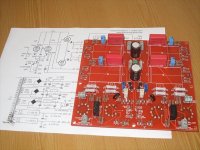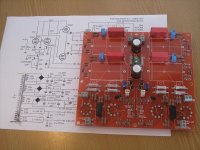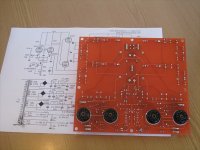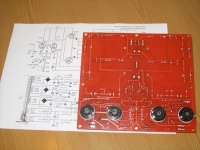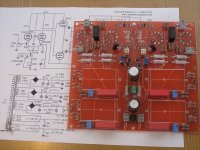PP2010 50w Vacuum Tube Amplifier < the best sound of the last years
design by Andrea-Cicufflo
INTRODUCTION
After many years designing single ended amplifiers I have decided to start a series of test about the Push Pull amplifiers.
These amplifiers are considered at a lower level than single ended but if you want a power enough to drive ESL loudspeakers and low distortion systems like Audiotechnology, Dynaudio, Scanspeak, Morel and Seas there is no other choice.
The main problem of Push-pull amplifier is the not perfect distortion decay with the cancellation of even harmonics but if we keep the distortion level very low this consequence can be ignored and the sound will not be affected.
Another characteristic of many Push-pull amplifier is the high global feedback used to get a good damping factor because to increase the output power often are used output transformers with low turn ratio.
As my others amplifiers to preserve the signal I have used the minimum number of components on the signal path so only one inter stage capacitor is present.
Here I would like to create a Push-pull taking only the benefits of this design and minimizing the bad effects.
PP2010 - Push Pull test
PP2010 - Push Pull test
the complete project
PP2010 - Hi-End Push Pull Amplifier
design by Andrea-Cicufflo
INTRODUCTION
After many years designing single ended amplifiers I have decided to start a series of test about the Push Pull amplifiers.
These amplifiers are considered at a lower level than single ended but if you want a power enough to drive ESL loudspeakers and low distortion systems like Audiotechnology, Dynaudio, Scanspeak, Morel and Seas there is no other choice.
The main problem of Push-pull amplifier is the not perfect distortion decay with the cancellation of even harmonics but if we keep the distortion level very low this consequence can be ignored and the sound will not be affected.
Another characteristic of many Push-pull amplifier is the high global feedback used to get a good damping factor because to increase the output power often are used output transformers with low turn ratio.
As my others amplifiers to preserve the signal I have used the minimum number of components on the signal path so only one inter stage capacitor is present.
Here I would like to create a Push-pull taking only the benefits of this design and minimizing the bad effects.
PP2010 - Push Pull test
PP2010 - Push Pull test
the complete project
PP2010 - Hi-End Push Pull Amplifier
Last edited:
You should look at early up to 1960's tube circuits.
Fisher had, on larger amps, three negative feedback paths, so low total feedback, and there where many other designs that gave Class-A tone, with great dynamics.
One way, is have lower gain on the phase-inverter circuit, and make sure the driver stage is completely balanced with no negative feedback. Then less correction feedback required. Also topology of input stages to push-pull tubes important.
Usually isolating phase inverter so it can run without loading, keep inversion balanced, and then low impedance drive to pentode grids, running cathode bias for higher impedance on the grids of the output tubes....
Fisher had, on larger amps, three negative feedback paths, so low total feedback, and there where many other designs that gave Class-A tone, with great dynamics.
One way, is have lower gain on the phase-inverter circuit, and make sure the driver stage is completely balanced with no negative feedback. Then less correction feedback required. Also topology of input stages to push-pull tubes important.
Usually isolating phase inverter so it can run without loading, keep inversion balanced, and then low impedance drive to pentode grids, running cathode bias for higher impedance on the grids of the output tubes....
- Status
- This old topic is closed. If you want to reopen this topic, contact a moderator using the "Report Post" button.
- Home
- More Vendors...
- Quanghao Audio Design
- Push-Pull amplifier driver stage
